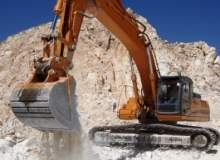
Australia is one of the largest mineral producers in the world and holds large reserves of various minerals, including nickel and bauxite. Australia managed to avoid recession in the review period and as a result, its mining industry is expected to grow from 2009-15, driven by planned infrastructure projects and export demands from China. Both the mining equipment industry and mining exploration expenditure are also expected to increase, although a proposed mining tax may hinder mining companies’ profits in the forecast period.
Mineral production to increase in forecast period
As the Australian economy remained relatively unaffected by the global economic recession, from 2004-09, its mineral production value increased at a CAGR of more than 17% and more than doubled, reaching nearly US$80 billion. From 2009-15 this growth is expected to continue as a result of planned infrastructure projects worth approximately US$20 billion, and increasing demand for mineral exports from China, whose economy is rapidly growing. As a result, China is expected to replace Japan as the largest importer of Australian minerals. In this period, mineral production in Australia is expected to increase from just more than 1,000 million tons to nearly 1,200 million tons.
In addition to high levels of Chinese export demand, China is a major foreign investor in the Australian mining industry. Australia is an attractive opportunity for foreign investment because of its political stability and low levels of political interference. However, in order to contain the flow of Chinese investment into its mining industry, the Australian government introduced regulation to restrict foreign investment in state-owned companies to no more than 15%.
Australia has rich mineral resources
With huge reserves and production capacity, Australia is among the top ten mining countries in the world. Australia holds approximately 35% of global nickel reserves and nearly 23% of global bauxite reserves. As a result, in 2009 Australia contributed more than 30% to global bauxite production and nearly 15% to global nickel output. In this year, Australia was also ranked as the third largest producer of iron ore.
Metallic minerals share to remain stable and coal to grow
In 2009, metallic minerals dominated the Australian mining industry in terms of volume with a market share of nearly 50%. This was followed by coal with nearly 45% and non-metallic minerals with approximately 8%. In the forecast period, whilst the share of coal in expected to marginally increase at the expense of non-metallic minerals, the share of metallic minerals is expected to remain the same.
The increase in coal production will be driven by domestic power generation, as in 2008 three quarters of Australia’s electricity was generated through coal, and nearly 90% of all coal produced was used in electricity generation. With increasing industrialization and population growth, demand for electricity is expected to increase, and with it, the demand for coal. According to the Energy Information Administration (EIA), from 2006-30, Australian domestic coal consumption is expected to increase at a CAGR of approximately 0.5% per annum.
How well do you really know your competitors?
Access the most comprehensive Company Profiles on the market, powered by GlobalData. Save hours of research. Gain competitive edge.

Thank you!
Your download email will arrive shortly
Not ready to buy yet? Download a free sample
We are confident about the unique quality of our Company Profiles. However, we want you to make the most beneficial decision for your business, so we offer a free sample that you can download by submitting the below form
By GlobalDataThe metallic minerals category experienced a CAGR of nearly 10% from 2004-09, driven by demand from steel and aluminum manufacturers and the automobile industry, which uses large amounts of both minerals. From 2008-09, total vehicle registration in Australia increased from just more than 15 million to nearly 16 million and this growth will further increase demand for metallic minerals from the automobile industry. Demands for iron ore are also expected to increase and this will aid the Australian mining industry, as it supplies approximately 40% of global iron ore.
Mining equipment industry forecast to grow after 2011
From 2008-09, the Australian mining equipment industry declined by approximately 12% due to a decrease of nearly 10% in exploration expenditure, as a result of the global financial crisis. However, after 2011 the mining equipment industry is expected to grow as a result of increased demand for minerals and an increase in private investment.
Mining exploration expenditure to increase
In the review period, mining exploration expenditure decreased approximately 20% for uranium, but increased from 25%-40% for iron ore, coal, phosphate and many other minerals. In addition to this, in 2009 alone, exploration drilling fell by nearly 20%. However, as mineral prices increase throughout the forecast period, it is expected that mineral exploration expenditure will also increase. This is particularly the case for iron ore, which is in strong demand from China.
Proposed mining tax may damage mining companies
The Australian Government has proposed the Resources Super Profits Tax (RSPT) which aims to tax mining company profits by approximately 40%, and increase the amount employees pay into pension funds by one-third. It is thought this tax will lead to an immediate decrease in operating costs which would negatively impact mining industry operations and profits.
In order to purchase the full version of this report, ‘Australian Mining Industry – Market Opportunities and Entry Strategies, Analyses and Forecasts to 2015,’ please click here.
ICD Research is a full-service market research consultancy providing both online and offline research capabilities. Our areas of expertise include online research, qualitative and quantitative research, custom approaches and actionable insights. Our capabilities provide a one-stop research and analysis service with full-spectrum consulting, from problem recognition and conducting fieldwork to the delivery of strategic recommendations. We deliver our expertise across a broad range of industry sectors and product lifecycle areas. From product innovation to brand management and CRM, we offer full service research and analysis that drives loyalty and lifetime value.



